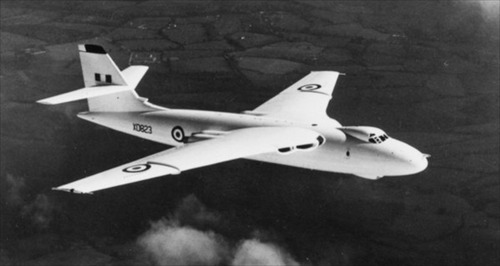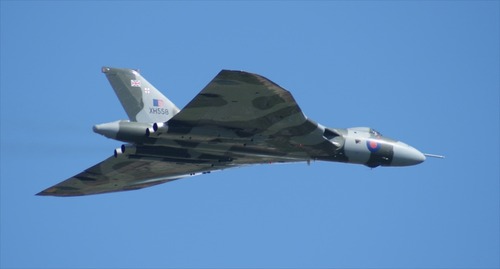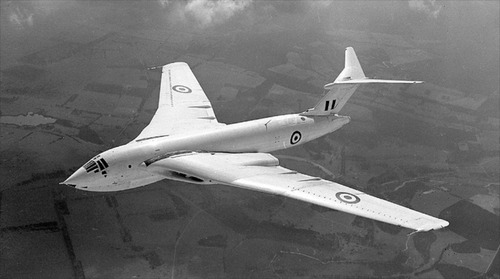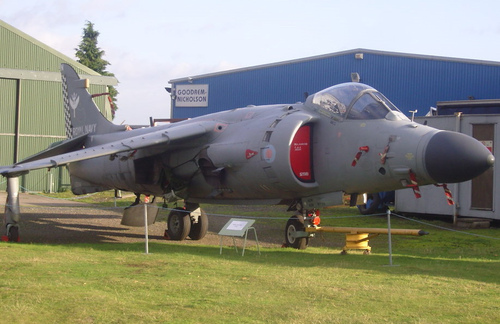V for Victory
 Sunday, April 29, 2012 at 6:03PM
Sunday, April 29, 2012 at 6:03PM It has now been 30 years since the Falklands war started and the various anniversaries surrounding the events that led to the British recapturing the islands are being remembered. While there are many stories from the islands' recapture to be told, the one story that continues to capture the imagination is how the RAF's cold war era bombers flew 15,000 km to undertake the longest bombing mission in history.
While the Black Buck missions were a fantastic example of just what the RAF could do when called upon, the seven missions flown were arguably the greatest moment for Britian's force of V bombers. While there are many articles going into great details about the war, and black buck missions in particular, it also piqued an interest in the V bombers.
The three V bombers, the Vickers Valiant, the Avro Vulcan and the Handley Page Victor, were all designed in the 1950s to drop nuclear bombs on the Soviet Union. In the 50s the biggest threat to Bombers were fighter aircraft and the best way to protect a bomber was to fly high and fast, so the three V bombers were designed to fly medium range missions fast and at high altitude. Unfortunately the V bombers were designed before the development of surface to air missiles, and following the introduction of frontline missiles it became clear that speed and altitude were no refuge for a bomber. Over night the V bombers became vulnerable at altitude so the RAF had to quickly change tactics and retrained the bomber crews to fly low level attack runs. Flying through the 'thick' turbulent air at low altitudes puts very different stresses on an airframe and the switch from high to low altitude flying was to have a significant impact on the V bombers.
 The Vickers Valiant (photo courtesy of Flickr user kitchener.lord)Introduced to the RAF in 1955, the Valiant was the first to fly and was to be the most traditional of the three V bomber designs in case the more advanced Victors and Vulcans failed to meet their design goals. While the Valiant retained the bombing role until it was retired, it was already being moved to the mid-air refuelling role when, in 1964, a Valiant suffered an in-flight failure of its rear spar (the main structural member of the wing). Despite causing significant structural damage to the wing, including the loss of sections of the flaps, the crew managed to successfully land the aircraft. The metal fatigue caused by the higher stresses of low level flying doomed the Valiant, and within six months the entire fleet of over 100 aircraft had been grounded.
The Vickers Valiant (photo courtesy of Flickr user kitchener.lord)Introduced to the RAF in 1955, the Valiant was the first to fly and was to be the most traditional of the three V bomber designs in case the more advanced Victors and Vulcans failed to meet their design goals. While the Valiant retained the bombing role until it was retired, it was already being moved to the mid-air refuelling role when, in 1964, a Valiant suffered an in-flight failure of its rear spar (the main structural member of the wing). Despite causing significant structural damage to the wing, including the loss of sections of the flaps, the crew managed to successfully land the aircraft. The metal fatigue caused by the higher stresses of low level flying doomed the Valiant, and within six months the entire fleet of over 100 aircraft had been grounded.
 Avro Vulcan (photo courtesy of Flickr user cooldudeandy01)Ironically the high altitude Vulcan proved to be a rather good low level bomber. The huge wing area afforded by the Vulcan's futuristic delta wing design gave it a very low wing loading (loaded weight of the aircraft divided by the area of the wing) which made it by far the most suitable of the V bombers for flying the more demanding low level bomb runs. For this reason the Vulcan was the last of the V bombers to actually drop bombs.
Avro Vulcan (photo courtesy of Flickr user cooldudeandy01)Ironically the high altitude Vulcan proved to be a rather good low level bomber. The huge wing area afforded by the Vulcan's futuristic delta wing design gave it a very low wing loading (loaded weight of the aircraft divided by the area of the wing) which made it by far the most suitable of the V bombers for flying the more demanding low level bomb runs. For this reason the Vulcan was the last of the V bombers to actually drop bombs.
 Handley Page Victor (photo courtesy of Flickr user kitchener.lord)Despite suffering from the same low level flying fatigue problems as the Valiant, the Victor faired somewhat better. In 1964 the early versions of the Victor, which were already surplus to the strategic bomber role, were converted to fill the tanker role left by the retirement of the Valiant fleet. The later versions of the Victor were all retired from the strategic bombing role by 1968 and were converted to tankers replacing the earlier first generation Victor tankers. These more capable Victor tankers literally had their wings clipped as 18 inches was removed from each wing-tip to reduce the stress on the wing to extend the airframe's life. The Victor's history as a bomber gave it a advantage that few other ariel tankers have, as well as the ability to refuel aircraft it could itself be refuelled in mid-air, in fact it was this feature that allowed the RAF to even contemplate the Black Buck missions.
Handley Page Victor (photo courtesy of Flickr user kitchener.lord)Despite suffering from the same low level flying fatigue problems as the Valiant, the Victor faired somewhat better. In 1964 the early versions of the Victor, which were already surplus to the strategic bomber role, were converted to fill the tanker role left by the retirement of the Valiant fleet. The later versions of the Victor were all retired from the strategic bombing role by 1968 and were converted to tankers replacing the earlier first generation Victor tankers. These more capable Victor tankers literally had their wings clipped as 18 inches was removed from each wing-tip to reduce the stress on the wing to extend the airframe's life. The Victor's history as a bomber gave it a advantage that few other ariel tankers have, as well as the ability to refuel aircraft it could itself be refuelled in mid-air, in fact it was this feature that allowed the RAF to even contemplate the Black Buck missions.
In the early 80s the UK government was pushing for defence cuts that would alter the structure of the armed forces to concentrate on its role within NATO. Given that the RAF could provide air cover for UK Forces within the area of its Nato responsibilities the planned cuts were to reduce the Royal Navy's ability to conduct independent operations outside of NATO. Despite the RAF lack of a long range deployment capability the proposed cuts required the Royal Navy to decommission large number of Destroyers, Frigates and Amphibious ships and to sell its Aircraft Carriers. That all changed on the 2nd of April 1982 when Argentinean forces invaded the Falklands, the very type of crisis that the defence review assumed could not happen. The nearest suitable airfield to conduct air operations from was on Ascension Island, but the RAF station on Ascension was still over 7,000 kilometres from the Falklands, a range that was far beyond the operational capability of RAF fighters and bombers. Plans to sell the Aircraft Carriers were halted and a task force built around the Royal Navy carriers HMS Hermes and HMS Invincible was put together to recapture the islands.
While the Royal Navy's fleet of carrier based Sea Harriers would drop the vast majority of bombs during the war, the RAF put together a plan to bomb the airfield at Port Stanley. The 15,000 km return trip from Ascension to the Falklands was aproblem for the Vulcan, it's maximum range of just over 4,000 km required it to be refueled in-flight. The Vulcans had been assigned to NATO for nuclear operations within Europe which meant that neither conventional bombing nor air-to-air refuelling had been practised for several years. The mid-air refuelling systems were reinstalled and after some bombing practice a fleet of Vulcan bombers and Victor refuelling tankers arrived at Ascension. Even with the Victor's greater range of over 9,000 km they would also still need to be refueled mid-flight. In total, each of the bombing missions required two Vulcans (in case of problems in the early stages of the mission, the second aircraft would take over) and eleven Victors to get 21 1,000 lb bombs to Port Stanley. Each bombing run used 137,000 gallons of aviation fuel (enough for 260 bombing runs using the Royal Navy's Sea Harriers), with the seven missions using almost 1 million gallons of fuel. Despite having to steam from Portsmouth to the Falklands before being able to launch ground attacks with the Sea Harriers the RAF only beat the Navy to dropping bombs on Port Stanley by a matter of a few hours.
 An updated version of the Sea Harriers that saw action in the Falklands (Flickr user sasiphus)What is less well known about the Black Buck missions is that they significantly shortened the remaining life of the Victor fleet, the only mid-air refuelling platform the RAF had. While the RAF had planned to retired the Victor tankers with the introduction of tankers based on the newer Vickers VC10 and Lockheed Tristar commercial airliners, the black buck missions burned through so many of the Victor fleet's remaining flight hours that the RAF had to convert six Vulcans to tanker configuration as a stopgap measure before the VC10 and Tristar aircraft could be introduced.
An updated version of the Sea Harriers that saw action in the Falklands (Flickr user sasiphus)What is less well known about the Black Buck missions is that they significantly shortened the remaining life of the Victor fleet, the only mid-air refuelling platform the RAF had. While the RAF had planned to retired the Victor tankers with the introduction of tankers based on the newer Vickers VC10 and Lockheed Tristar commercial airliners, the black buck missions burned through so many of the Victor fleet's remaining flight hours that the RAF had to convert six Vulcans to tanker configuration as a stopgap measure before the VC10 and Tristar aircraft could be introduced.
While the Valiant was gone by 1964, and the Vulcan retired in 1984, the Victor remained in front line service until 1993. Despite being the only V Bomber to never serve in war as a bomber the Victor did see active service in the Falklands and the first Gulf war. While historians will argue about the strategic value of the black buck missions for years to come, their tactical success was minimal. While the raids on Port Stanley turned the Vulcan into a hero it was perhaps the more conventional looking Handley Page Victor that was the most successful of Britain's 1950's V bombers.
Notes;
As for the carriers, HMS Invincible was commissioned in 1980, retired in 2005 and ultimately scrapped in 2011. Despite work on HMS Hermes starting during World World 2 she wasn't commissioned until 1959. Decommissioned in 1984, she was sold to the Indian Navy in 1986, renamed INS Viraat and is expected to remain in service until 2020
Interestingly, despite their very different size and roles, both HMS Invincible and Avro's Vulcan were each powered by four Rolls Royce Olympus engines. Invincible's four Olympus engines could propel the 22,000 tonne carrier at over 50 km/h, while the four Olympus engines could get a 92,000 kg fully laden Vulcan into the air, and up to 15,000 metres at over 1,000 km/h



Reader Comments